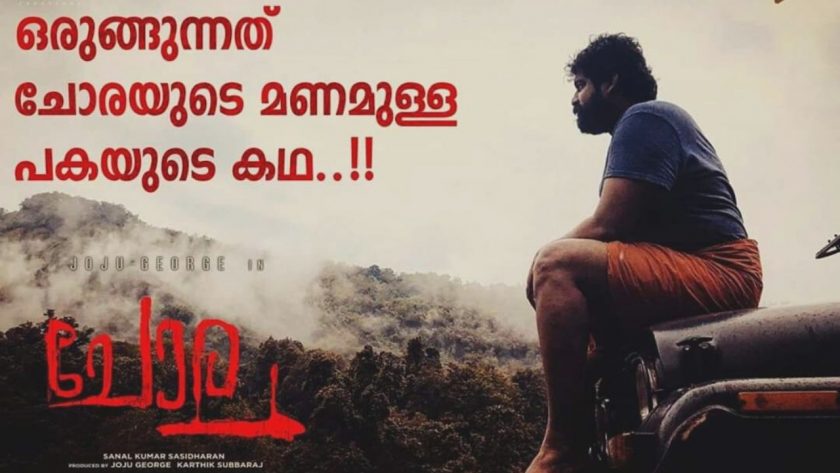In this years Kumbalangi Nights, written by Syam Pushkaran, Shammy (a patriarchy personified character) says to Saji, ‘Ramayanam ezhuthiyath etho kaattalan alle?‘ Isn’t Ramayana written by some forest dweller. In Fact we are bound with the same stories that have been written by anonymous people thousands of years ago. The contemporary sight is a repetition. Powerplay of patriarchy and women being sole prey for oppression is recurring for ages. Chola is a twisted reinterpretation to the Ramayana with a horror disguised inside the road-movie genre.
Nimisha and Joju’s Career-Best Performances
The film begins as if a grandmother is dictating a fictional story to her granddaughter. It’s about a woman in a forest who has treasure, and what is this treasure? Virginity. An intelligent prince who’s afraid of blood is told by his minister to conquer this treasure in this woman, but the prince doesn’t yet know what it is. He claims the woman wholly. Woman is been a property for men to bargain. I remember a dialogue from Abhishek Chaubey’s Sonchiriya that says, Brahmans, Thakurs, Baniyas, Shudras… these castes were made to categorise men. Women have an entirely different caste. Women are the lowest of the low. Chola too, out of this conceit is about women who are bound to remain as shadows of men. And virginity being a treasure.
Chola: Unveiling the Shadows of Oppression in Sanal Kumar Sasidharan’s Film
Nimisha Sajayan is Janaki, which is also another name for Sita. Akhil Vishwanath is Raman, the boyfriend. He is not designated with names. Joju George too is only baptised as Aashan, The Raavanan. His physique is almost double that of this couple. In the shopping complex scene the distant shot that spans around the three gives a clear picture of this ‘gargantuan’ conceit. Joju’s T-shirt is also emphasised with Eat, Eat, Eat. Janaki and her boyfriend is arranged for ride with his boss to visit the city behind her mother’s back.
It starts as a road movie. But there is some eerie association of wind, mist, cricket sounds and small noises. It also rains, as if nature is being an inevitable part of this scrawling environment. Joju’s creepy interludes and the stairs to this couple is sinister. Sanal arranges few god’s-eye-view shots to lighten the chilling event. The road-movie genre transcends into horror as soon as the events gets worse and they get rearranged into a motel for the night.
Captivating Narratives and Atmospheric Brilliance in Chola
The tone shifts as that brilliant sneak peek Sanal Kumar Sasidharan posted as Chola’s first promo video reaches. The camera spins over. It almost caused a migraine. But what really impacted is the event. It’s brutal. The preying is exquisitely staged. Chola shifts gear again as it enters the forest. Aashan is not done. His sexual fantasies and patriarchal monopoly takes the ‘chill’ to a ferociously chilling level. Water comes as an important leitmotif. Aashan swims through the waterfalls, he enjoys the surrounds with Janaki. This is straight out from Sanal’s own Ozhivu Divasathe Kali, the waterfront in that film resembles Chola. Joju’s heinous power play (The scenery from the waterfalls) reminded me Unni R’s short story Leela.
Patriarchy’s Grip: Exploring the Systematic Oppression of Women in Chola

Chola translates to Shadow of Water in English. The woman are exactly like a shadow in Sanal’s film. Marginalised and clearly oppressed. The misogyny that has been written thousands of years ago in Hindu literature have been our way of living. It has been like a system owned by Patriarchy. Women are bound to patriarchy in the rural insights of India. In one of the posters of the film, India’s map is camouflaged with Joju’s image. Sanal’s film is about oppression and oppressed. It is not a feminist film. But the ultimate results are pessimistic.
The climax sequence is terrific. Janaki’s boyfriend’s psyche disorients and what really turns him on is that he couldn’t be the savour of her virginity, this connects to the opening fairy tale as well. His patriarchal ego is hurt. Another interesting irony to this was his phone ringtone that plays Ammave Vanangathe song from the Tamil film Mannan. What begins with an ounce of fire dissolves in water. The title design is twisted. In the first instance it’s read as Chora (Blood). And this bloody savagery is what we see in the climax.
Terrific Climax and Symbolism: Decoding the Cinematic Brilliance of Chola
Nimisha and Joju has already received accolades for their performances. It’s undoubtedly career best for both of them. Nimisha’s portrayal could have been easily gone wrong as this is a character that should have taken care with utmost sensitivity. And, Nimisha doesn’t overdo this. Her verbal effort is superb and some of the silent gazes almost makes you feel guilty. Joju is incredibly wicked as Aashan and gives a terrifying effect with his beefed up body and riveting smiles. Akhil’s performance is fittingly external.
There is some inhibitions for people about the films that premiered in film festivals categorising them as “Award-movie” sort of thing. But let me tell you, Sanal Kumar Sasidharan’s visual grammar is contrasting to that of any other filmmaker who makes art house films. There are long held shots and silent moments but with an amalgamation of ‘Nature’ so brilliantly into this monstrosity, Sanal’s film is captivating from the word go. The sound design is a marvel. Chola is terrifically atmospheric, the last time a film made me squirm-the-seat was Lijo Jose Pellissery’s Ee Ma Yau. This is in every regard a film designed for theatrical viewing because the soundscape is that brilliant.

CA Student who’s enthusiastic about films.


Be the first to comment on "Chola (Review)"